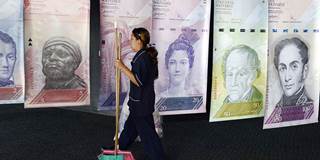Usually, a sudden stop in capital inflows sparks a currency crash, sometimes a banking crisis, and quite often a sovereign default. Why, then, has the worldwide incidence of sovereign defaults in emerging markets risen only modestly?
CAMBRIDGE – Booms and busts in international capital flows and commodity prices, as well as the vagaries of international interest rates, have long been associated with economic crises, especially – but not exclusively – in emerging markets. The “type” of crisis varies by time and place. Sometimes the “sudden stop” in capital inflows sparks a currency crash, sometimes a banking crisis, and quite often a sovereign default. Twin and triple crises are not uncommon.
The impact of these global forces on open economies, and how to manage them, has been a recurring topic of discussion among international policymakers for decades. With the prospect of the US Federal Reserve raising interest rates in the near and medium term, it is perhaps not surprising that the International Monetary Fund’s 18th Annual Research Conference, to be held on November 2-3, is devoted to the study and discussion of the global financial cycle and how it affects cross-border capital flows.
Rising international interest rates have usually been bad news for countries where the government and/or the private sector rely on external borrowing. But for many emerging markets, external conditions began to worsen around 2012, when China’s growth slowed, commodity prices plummeted, and capital flows dried up – developments that sparked a spate of currency crashes spanning nearly every region.

CAMBRIDGE – Booms and busts in international capital flows and commodity prices, as well as the vagaries of international interest rates, have long been associated with economic crises, especially – but not exclusively – in emerging markets. The “type” of crisis varies by time and place. Sometimes the “sudden stop” in capital inflows sparks a currency crash, sometimes a banking crisis, and quite often a sovereign default. Twin and triple crises are not uncommon.
The impact of these global forces on open economies, and how to manage them, has been a recurring topic of discussion among international policymakers for decades. With the prospect of the US Federal Reserve raising interest rates in the near and medium term, it is perhaps not surprising that the International Monetary Fund’s 18th Annual Research Conference, to be held on November 2-3, is devoted to the study and discussion of the global financial cycle and how it affects cross-border capital flows.
Rising international interest rates have usually been bad news for countries where the government and/or the private sector rely on external borrowing. But for many emerging markets, external conditions began to worsen around 2012, when China’s growth slowed, commodity prices plummeted, and capital flows dried up – developments that sparked a spate of currency crashes spanning nearly every region.